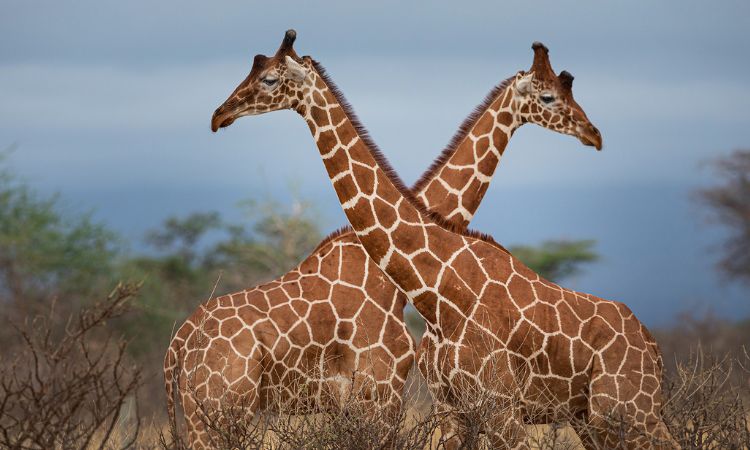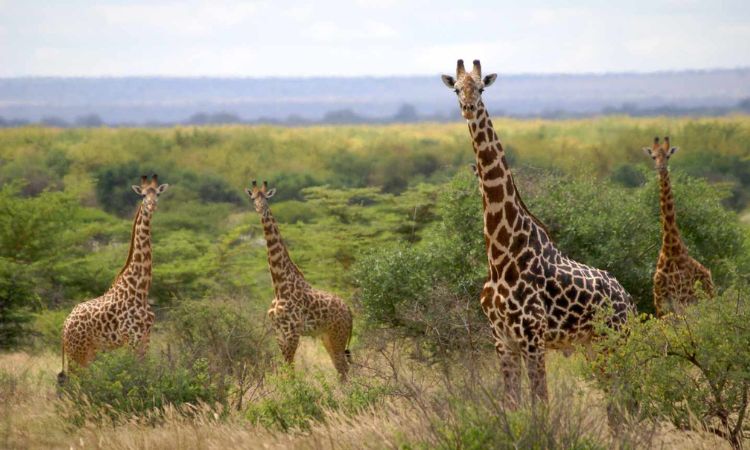Giraffe Facts, Species, Habitat, Diet & Interesting Behaviors Explained
Giraffe: Discover everything about giraffes — their species, diet, behavior, and habitat. Learn why giraffes are the tallest animals on Earth and how they survive in the wild.
Introduction to the Majestic Giraffe
The giraffe (Giraffa camelopardalis), the tallest animal on Earth, is an awe-inspiring symbol of Africa’s wild beauty. Standing at an average height of 14–18 feet (4.3–5.5 meters) and weighing between 1,750–2,800 pounds (800–1,270 kg), these gentle giants roam the savannahs and woodlands of eastern, southern, and central Africa.
With their long necks, distinctive coat patterns, and calm demeanor, giraffes play a vital role in their ecosystems. This article explores giraffe facts, their habitat, diet, behavior, species, conservation status, and where to see them in the wild, offering insights for wildlife enthusiasts and travelers alike.
Understanding giraffes is key to appreciating their conservation importance and ensuring their survival for future generations.
Giraffe Habitat and Distribution
Giraffes thrive in the open landscapes of Africa, primarily in savannahs, grasslands, and open woodlands rich with acacia trees.
Their geographic range spans countries like Kenya, Tanzania, Uganda, South Africa, Botswana, Namibia, and Chad. Notable national parks where giraffes are commonly spotted include:
- Murchison Falls National Park, Uganda: A prime destination for seeing Northern giraffes in their natural habitat.
- Serengeti National Park, Tanzania: Home to large populations of Masai giraffes.
- Kruger National Park, South Africa: A hotspot for Southern giraffes.
- Etosha National Park, Namibia: Offers excellent opportunities to observe giraffes in open savannahs.
These locations attract safari-goers searching for unforgettable wildlife encounters, making them ideal for travel-related searches.
Giraffe Diet: What Giraffes Eat
Giraffes are herbivores with a specialized diet that takes advantage of their extraordinary height. They primarily feed on leaves, shoots, and fruits from tall trees, especially acacia, mimosa, and wild apricot trees.
Their 18-inch (45 cm) prehensile tongues, which are tough and dark-colored to protect against thorns and sunburn, allow them to pluck foliage from high branches that other animals cannot reach.
Interestingly, giraffes have minimal water needs and can go weeks without drinking, obtaining moisture from the plants they consume. Their efficient digestive systems enable them to extract maximum nutrients from tough, fibrous vegetation, supporting their massive size.
Giraffe Behavior and Social Life
Giraffes are social creatures that live in loose, fluid herds, often consisting of females and their calves or bachelor groups of males.
Their communication methods are fascinating, including infrasound (low-frequency sounds humans cannot hear), body language, and physical movements.
Male giraffes engage in “necking” battles, swinging their long necks to establish dominance and secure mating opportunities.
Mothers are fiercely protective, often forming nursery groups to collectively care for calves. Giraffes are also known for their calm and curious nature, often observing their surroundings with a serene demeanor, making them a favorite among safari-goers.
Giraffe Species and Subspecies
Recent research identifies four main giraffe species, each with distinct coat patterns and regional distributions:
|
Species |
Region |
Notable Features |
|
Masai Giraffe |
Tanzania, Kenya |
Irregular, star-like spots |
|
Reticulated Giraffe |
Kenya, Somalia |
Net-like coat pattern |
|
Northern Giraffe |
Uganda, Chad |
Lighter patches |
|
Southern Giraffe |
South Africa, Namibia |
Rounded spots |
These distinctions help conservationists tailor protection efforts to specific populations, as each species faces unique threats.

Giraffe Reproduction and Lifespan
Giraffe reproduction is a remarkable process. After a gestation period of about 15 months, females give birth to a single calf, which is born standing up and can walk within hours. Calves are vulnerable to predators, so mothers remain vigilant, often forming nursery groups to share caregiving duties.
In the wild, giraffes have an average lifespan of 20–25 years, though they may live longer in captivity. Their long lives and slow reproductive cycles make population recovery challenging in the face of threats.
Unique Physical Adaptations
Giraffes are marvels of evolutionary adaptation, perfectly suited to their environment:
- Long Necks: Allow access to high foliage, giving them a competitive edge over other herbivores.
- Powerful Hearts: A giraffe’s heart, weighing up to 25 pounds, pumps blood against gravity to reach the brain.
- Long Legs: Enable speeds of up to 37 mph (60 km/h) to evade predators.
- Spotted Coat: Provides camouflage among trees and savannah grasses.
These adaptations make giraffes uniquely equipped to thrive in their challenging habitats.
Giraffe Predators and Threats
While adult giraffes have few natural predators due to their size and powerful kicks, calves are vulnerable to lions, hyenas, and leopards. Human-related threats pose a greater danger, including:
- Poaching: For their hides, tails, and meat.
- Habitat Loss: Due to agricultural expansion and urban development.
- Civil Conflict: Disrupting conservation efforts in some regions.
Organizations like the Giraffe Conservation Foundation (GCF) work tirelessly to protect giraffes through habitat restoration and anti-poaching initiatives.
Giraffe Conservation Status
Giraffes are classified as Vulnerable by the International Union for Conservation of Nature (IUCN), with their population declining to fewer than 120,000 individuals in the wild.
Habitat fragmentation, poaching, and human-wildlife conflict are major contributors to this decline. Conservation efforts, led by organizations like the GCF, focus on:
- Protecting and restoring giraffe habitats.
- Monitoring populations through community-based programs.
- Raising awareness about giraffe conservation.
Supporting these initiatives is crucial to ensuring giraffes remain a vibrant part of Africa’s ecosystems.
Interesting Giraffe Facts
Readers love quick, engaging facts that highlight the uniqueness of giraffes. Here are some fascinating tidbits:
- A giraffe’s tongue is black and up to 18 inches long, perfect for grabbing thorny branches.
- They sleep only about 30 minutes a day, often in short “dive naps.”
- Each giraffe’s coat pattern is as unique as a human fingerprint.
- Giraffes can clean their ears with their long tongues.
- Calves are born after falling nearly 6 feet to the ground during birth.

Where to See Giraffes in Africa
For travelers eager to witness giraffes in their natural habitat, Africa offers incredible safari destinations:
- Murchison Falls National Park, Uganda: A haven for Northern giraffes, with scenic boat safaris along the Nile.
- Serengeti National Park, Tanzania: Famous for its vast herds of Masai giraffes and the Great Migration.
- Masai Mara National Reserve, Kenya: Ideal for spotting Reticulated giraffes against stunning landscapes.
- Etosha National Park, Namibia: Offers excellent viewing of Southern giraffes at waterholes.
Booking a safari in these locations promises an unforgettable giraffe-spotting experience.
FAQs About Giraffes
How tall is a giraffe?
Giraffes stand between 14–18 feet tall, with males typically taller than females.
What do giraffes eat?
Giraffes are herbivores, primarily eating leaves, shoots, and fruits from acacia and other tall trees.
How long do giraffes live?
Giraffes live 20–25 years in the wild, though they may live longer in captivity.
Are giraffes endangered?
Giraffes are classified as Vulnerable by the IUCN due to population declines from habitat loss and poaching.
Where can I see giraffes in Uganda?
Murchison Falls National Park is a top destination for seeing Northern giraffes in Uganda.
Conclusion: Why Giraffes Are Worth Protecting
Giraffes are among the most iconic and fascinating creatures on Earth, with their towering height, unique adaptations, and gentle nature captivating people worldwide.
However, their Vulnerable status reminds us of the urgent need to protect their habitats and combat threats like poaching and habitat loss. Whether you’re a wildlife enthusiast or planning a safari, giraffes offer a glimpse into the beauty of Africa’s ecosystems.
Ready to spot these gentle giants in the wild? Book a Uganda wildlife safari today and witness giraffes up close in their natural habitat, such as Murchison Falls National Park or Serengeti National Park. Your adventure supports conservation efforts and creates memories that last a lifetime.
